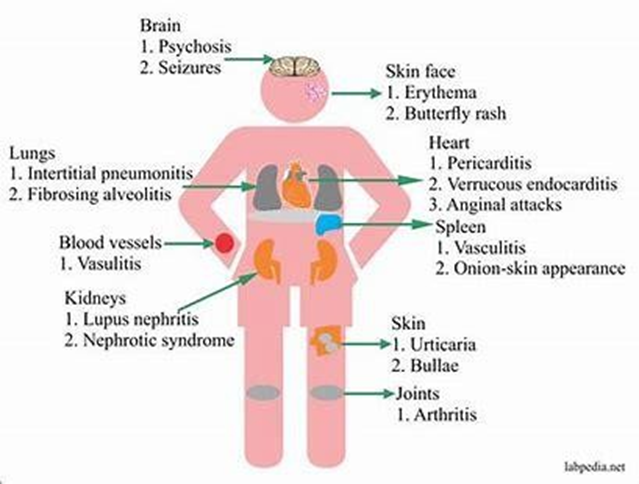A nurse is caring for a client who has systemic lupus erythematosus. During assessment, which of the following should the nurse expect to find?
Joint inflammation
Tophi
Esophagitis
"Bull's eye" lesion
The Correct Answer is A
A. Joint inflammation(arthritis) is a common manifestation of systemic lupus erythematosus. SLE can cause inflammation in the joints, leading to symptoms such as pain, swelling, stiffness, and decreased range of motion. It often affects the small joints of the hands, wrists, and knees.

B. Tophi are deposits of uric acid crystals that form under the skin in people with chronic gout.
C. Esophagitis, or inflammation of the esophagus, can occur in systemic lupus erythematosus as part of gastrointestinal involvement. However, it is not one of the most common manifestations of SLE.
D. "Bull's eye" lesion, also known as erythema multiforme, is a skin manifestation seen in conditions such as Lyme disease and certain drug reactions. It is not typically associated with systemic lupus erythematosus.
Nursing Test Bank
Naxlex Comprehensive Predictor Exams
Related Questions
Correct Answer is ["C","D","E","G"]
Explanation
The blood pressure is elevated. This may indicate a compensatory mechanism to try increases myocardial perfusion. However, this increases the oxygen demand worsening the condition.
Pain level of 7 indicates severe pain typical of acute coronary syndrome. The pain may worsen the extent of ischemia and hence morphine should be administered immediately
ECG findings are typical for myocardial infarction and intervention is key to prevent further myocardial damage.
Troponin levels are elevated due to damage of myocardium
Blood sugar level, bowel sounds and lung sounds are normal and therefore, requires no intervention.
Correct Answer is A
Explanation
A. Clients with flail chest often experience compromised respiratory function due to the paradoxical movement of the chest wall. Providing humidified oxygen can help improve oxygenation and maintain airway patency, especially if the client is experiencing hypoxia.
B. Administering antibiotic medication is not a primary intervention for a flail chest unless there is evidence of an associated infection, such as pneumonia
C. Fluid restriction is not typically indicated for a client with a flail chest unless there are specific indications, such as heart failure or renal dysfunction.
D. While managing pain is important, flail chest often requires more aggressive pain management strategies, such as opioid analgesics or regional anesthesia, especially if the pain is severe and affects respiratory effort. Acetaminophen alone may not be sufficient for effective pain control in this situation.
Whether you are a student looking to ace your exams or a practicing nurse seeking to enhance your expertise , our nursing education contents will empower you with the confidence and competence to make a difference in the lives of patients and become a respected leader in the healthcare field.
Visit Naxlex, invest in your future and unlock endless possibilities with our unparalleled nursing education contents today
Report Wrong Answer on the Current Question
Do you disagree with the answer? If yes, what is your expected answer? Explain.
Kindly be descriptive with the issue you are facing.
